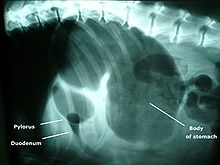胃擴張扭轉症

胃擴張扭轉症(英語:Gastric dilatation volvulus, GDV),又稱為胃扭轉(gastric torsion),是一種可能危及生命且必須及時治療的犬隻疾病。成因為犬隻胃部因含有過多氣體而造成過度拉伸和扭轉。GDV在部分犬種(如深胸犬)很常見。即使經過治療,死亡率也有10%-60%;若進行手術治療,死亡率則大致為15%-33%[1][2]。
胃擴張扭轉症的症狀不一定可以明顯地與其他疾病分別,犬隻可能會在沒有明顯原因下不舒服地站立。其他可能的症狀包括腹部劇烈膨脹、虛弱、抑鬱、呼吸困難、過度流涎和乾嘔。在許多患有GDV的犬隻身上也可以發現心律不整 [3]。犬隻的慢性胃擴張扭轉症症狀包括食欲不振、嘔吐和體重減輕等 [4]。
成因[編輯]
犬隻胃擴張腸扭轉症可能由多種因素引起。但在所有情況下,最直接的條件是食道和胃之間的括約肌功能障礙、以及幽門流出受阻 [5]。其它引起GDV的因素包括年齡、品種、深胸犬、食物在胃中膨脹、過度餵食、在運動前後的一小段時間內攝取大量的水、以及緊迫和其他胃腸道疾病 [6]。患有炎症性腸病的狗可能會增加腹脹的風險 [7]。
過去曾經普遍建議在犬隻進食的時候應該要把它們的食物碗抬高;但這實際上可能增加GDV的風險[8]。每天只吃一餐或飼料顆粒小於30 mm(1.2英寸)也可能使罹患GDV的風險提高[9][10]。雖然穀物、大豆和動物蛋白不會增加腹脹的機率,但添加較多油脂或脂肪的飲食確實會增加患病可能,這可能是由於胃排空延遲所致[11]。
病理生理學[編輯]
在胃擴張扭轉症的犬隻中,病患胃部環繞著消化道縱軸而扭轉。扭轉前後都可能發生腹脹[5]。從犬隻後側觀察,最常見的扭轉方向是順時針旋轉,胃部在這個方向最多可以旋轉360°;逆時針旋轉則可以到達90°。如果扭轉大於180°,食道就會受到擠壓而關閉,使犬隻無法通過打嗝或嘔吐來緩解病情[12]。胃擴張扭轉症亦可能造成低血壓、血液回流受阻、胃部缺血和休克;門靜脈如果受到擠壓會減少流向肝臟的血流,並降低該器官從血液中清除毒素和細菌的能力[13]。在胃的另一端,如果扭轉中斷脾臟血液供應,則可能造成脾臟壞死。如果不迅速治療,腹脹會導致敗血症、腹膜炎,最終導致毒性休克症候群而死亡。
診斷[編輯]
GDV的診斷取決於幾個因素,好發的犬種和病史通常會是嚴重懷疑罹患這種疾病的原因。理學檢查經常會發現明顯的腹部鼓脹;休克的診斷依據則是黏膜蒼白、微血管填充不良、心率加快或心律不整。影像學檢查可見胃部膨脹並充滿氣體。在正常犬隻下,幽門通常位於胃的右腹側;而GDV的犬隻則可見幽門偏移到腹中線的左側與胃體部的前側,而胃部在X光下則顯現為一個充滿空氣、分離成兩部分的囊袋樣構造[4]。
治療[編輯]
胃擴張扭轉症是一種急症,可能會在短時間內造成死亡;讓獸醫治療是絕對必要的。治療的方式通常包括輸液治療結合急診手術。急症初期胃部可以通過胃管減壓;如果無法通過胃管減壓,可以利用套管針穿刺皮膚進入胃部去除氣體;或是在麻醉後將套管針直接插入胃中以減少發生感染的機會。在手術過程中,將胃部放回正確位置、並檢查腹腔中是否有任何壞死的組織(尤其是胃和脾臟);如果發生胃壁壞死,可能需要進行局部胃切除手術。
預防[編輯]
GDV的復發是一個可能存在的問題。高達80%只接受藥物治療(未接受手術治療)的犬隻有復發的可能[14]。為了防止復發,在手術治療的同時經常合併進行右側胃固定術,通過各種方法將胃壁牢固地附著在體壁上,以防止胃部在腹腔內扭轉。雖然進行胃固定術的犬隻仍然可能出現腹脹,但胃扭轉復發的機會顯著減少 [15]。在罹患GDV的高風險族群中,也可以進行預防性胃切除術[14]。
其他有助於預防胃擴張扭轉症的措施包括少量多餐、而非全日僅一次大量進食,並且不要在進食前後運動[16]。
預後[編輯]
即時治療是預後良好的最重要因素。延遲治療超過6小時或出現腹膜炎、敗血症、低血壓或彌散性血管內凝血是預後不良的指標[2]。即使進行治療,死亡率也接近10%-40%[17]。手術治療的不良預後指標包括心律失常、脾切除或部分胃切除術。 [18]
流行病學[編輯]
一般而言,深胸犬罹患胃擴張扭轉症的風險最大。風險最大的5個品種是大丹犬、威瑪犬、聖伯納犬、戈登雪達犬和愛爾蘭雪達犬[19]。標準貴賓、愛爾蘭獵狼犬、德國短毛指針犬、德國牧羊犬、羅得西亞脊背犬、和50磅(23公斤)以下的巴吉度獵犬、臘腸犬也面臨罹患這種疾病的風險[1]<ref name="Merck"/。
參考資料[編輯]
- ^ 1.0 1.1 Aronson, Lillian R.; Brockman, Daniel J.; Brown, Dorothy Cimino. Gastrointestinal Emergencies. The Veterinary Clinics of North America. 2000, 30 (1): 558–569. PMC 1374121
 . PMID 10853276. doi:10.1016/s0195-5616(00)50039-4.
. PMID 10853276. doi:10.1016/s0195-5616(00)50039-4.
- ^ 2.0 2.1 Risk factors associated with short-term outcome and development of perioperative complications in dogs undergoing surgery because of gastric dilatation-volvulus: 166 cases (1992-2003). J. Am. Vet. Med. Assoc. 2006, 229 (12): 1934–9. PMID 17173533. doi:10.2460/javma.229.12.1934.
- ^ Canine gastric dilatation/volvulus syndrome in a veterinary critical care unit: 295 cases (1986-1992). J. Am. Vet. Med. Assoc. 1995, 207 (4): 460–4. PMID 7591946.
- ^ 4.0 4.1 Fossum, Theresa W. Gastric Dilatation Volvulus: What's New? (PDF). Proceedings of the 31st World Congress. World Small Animal Veterinary Association. 2006 [2007-04-17]. (原始內容 (PDF)存檔於2018-09-23).
- ^ 5.0 5.1 Gastric ulceration subsequent to partial invagination of the stomach in a dog with gastric dilatation-volvulus. J. Am. Vet. Med. Assoc. 2006, 228 (12): 1895–900. PMID 16784379. doi:10.2460/javma.228.12.1895.
- ^ Incidence of and breed-related risk factors for gastric dilatation-volvulus in dogs. J. Am. Vet. Med. Assoc. 2000, 216 (1): 40–5. PMID 10638316. doi:10.2460/javma.2000.216.40.
- ^ Gastric dilatation-volvulus in the dog with histological evidence of preexisting inflammatory bowel disease: a retrospective study of 23 cases. Journal of the American Animal Hospital Association. 1996, 32 (4): 287–90. PMID 8784718. doi:10.5326/15473317-32-4-287.
- ^ Non-dietary risk factors for gastric dilatation-volvulus in large and giant breed dogs. J. Am. Vet. Med. Assoc. 2000, 217 (10): 1492–9. PMID 11128539. doi:10.2460/javma.2000.217.1492.
- ^ Multiple risk factors for the gastric dilatation-volvulus syndrome in dogs: a practitioner/owner case-control study. Journal of the American Animal Hospital Association. 1997, 33 (3): 197–204. PMID 9138229. doi:10.5326/15473317-33-3-197.
- ^ Small size of food particles and age as risk factors for gastric dilatation volvulus in great danes. Vet. Rec. 1998, 143 (2): 48–50. PMID 9699253. doi:10.1136/vr.143.2.48.
- ^ The effect of ingredients in dry dog foods on the risk of gastric dilatation-volvulus in dogs. Journal of the American Animal Hospital Association. 2006, 42 (1): 28–36. PMID 16397192. doi:10.5326/0420028.
- ^ Gastric Dilatation-volvulus. The Merck Veterinary Manual. 2006 [2007-04-17]. (原始內容存檔於2016-03-04).
- ^ Bright, Ronald M. Gastric dilatation-volvulus: risk factors and some new minimally invasive gastropexy techniques. Proceedings of the 29th World Congress of the World Small Animal Veterinary Association. 2004 [2007-04-17]. (原始內容存檔於2009-04-15).
- ^ 14.0 14.1 Prospective evaluation of laparoscopic-assisted gastropexy in dogs susceptible to gastric dilatation. J. Am. Vet. Med. Assoc. 2002, 221 (11): 1576–81. PMID 12479327. doi:10.2460/javma.2002.221.1576.
- ^ A prospective study of survival and recurrence following the acute gastric dilatation-volvulus syndrome in 136 dogs. Journal of the American Animal Hospital Association. 1998, 34 (3): 253–9. PMID 9590454. doi:10.5326/15473317-34-3-253.
- ^ Wingfield, Wayne E. Veterinary Emergency Medicine Secrets. Hanley & Belfus, Inc. 1997. ISBN 978-1-56053-215-6.
- ^ Bloat. aspca.org. The American Society for the Prevention of Cruelty to Animals. [15 October 2017]. (原始內容存檔於July 1, 2014).
- ^ A retrospective study of factors influencing survival following surgery for gastric dilatation-volvulus syndrome in 306 dogs. Journal of the American Animal Hospital Association. March–April 2010, 46 (2): 97–102. PMID 20194364. doi:10.5326/0460097.
- ^ Analysis of risk factors for gastric dilatation and dilatation-volvulus in dogs. J. Am. Vet. Med. Assoc. 1994, 204 (9): 1465–71. PMID 8050972.
